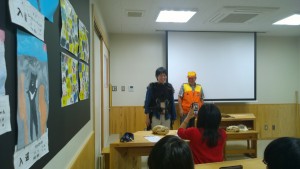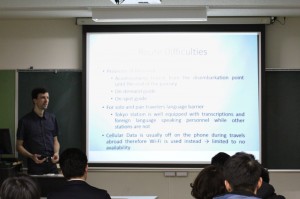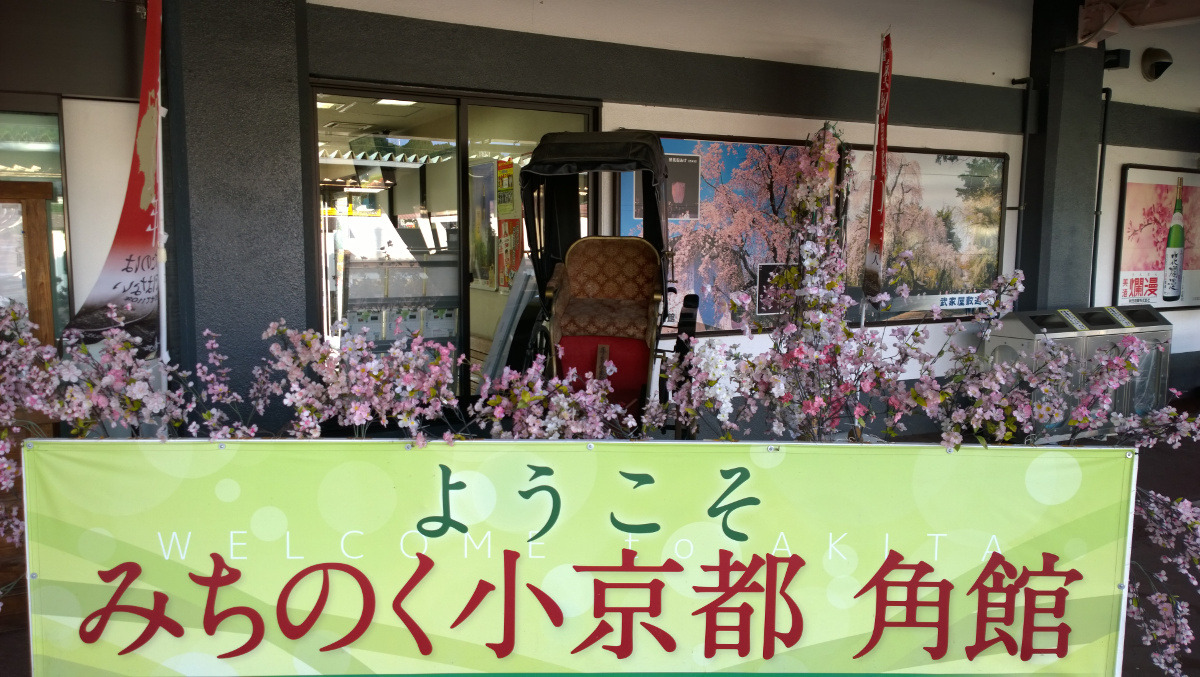AIU TOPICS
AIU Voices
Student Voice: Sergey Nizhnick, University of Latvia, Latvia
Academic Experience: Cultural Heritage Studies and Project-Based Learning
Cultural Heritage Studies
During the fall semester, I took Cultural Heritage Studies, where we focused on ways to apply cultural studies to promote tourism in Akita. My team developed a presentation targeted at Japan Railways (JR) on how they could promote travel to Japan, and particularly to remote regions like Akita, to an international audience.
Students took part in experiential tourism, including a visit to a Bear Garden.
For example, I analyzed and proposed the minimum amount of English language promotion and information and that would be required to support non-Japanese speaking tourists. I also researched how tourist-dependent facilities, such as the Selion Port Tower, and government offices could work together to better predict tourism numbers for more efficient service. We offered several proposals, including mobilizing local university and high school students.
My group project from that class culminated in a public presentation where we had members of the JR marketing team present and we could discuss our proposals one-on-one. We presented in English, but our professor translated our presentation into Japanese, too.
I have experience working as a marketing manager, so this was a great opportunity to use that expertise to contribute to Akita.

Being the only international student in the Cultural Heritage Studies and Project-Based Learning offered increased opportunities to interact with local students.
Winter Program Classes
Even though the winter classes are shorter and more intense, I’ve found that it is not significantly more difficult than the regular semester. So much of the focus is on interaction and what we do in the classroom, so it’s easy to get things done.
I especially like the intensity of the Japanese language courses during the winter! Class lasts for 3 hours per day, which is great for improvement!
Extracurricular Activities
I’ve been so involved in the PBL classes and research trips that I haven’t had time to participate regularly in any clubs, but I have still gotten to join several events.
I went on several of the bus trips – which were related to my cultural heritage tourism studies, anyway – and I’ve participated in school visits arranged by Research and Community Outreach Services (RCOS). I even got invited by a friend to go out and participate in rice planting as well.
Academic Experience: Cultural Heritage Studies and Project-Based Learning
Cultural Heritage Studies
During the fall semester, I took Cultural Heritage Studies, where we focused on ways to apply cultural studies to promote tourism in Akita. My team developed a presentation targeted at Japan Railways (JR) on how they could promote travel to Japan, and particularly to remote regions like Akita, to an international audience.
Students took part in experiential tourism, including a visit to a Bear Garden.
For example, I analyzed and proposed the minimum amount of English language promotion and information and that would be required to support non-Japanese speaking tourists. I also researched how tourist-dependent facilities, such as the Selion Port Tower, and government offices could work together to better predict tourism numbers for more efficient service. We offered several proposals, including mobilizing local university and high school students.
My group project from that class culminated in a public presentation where we had members of the JR marketing team present and we could discuss our proposals one-on-one. We presented in English, but our professor translated our presentation into Japanese, too.
I have experience working as a marketing manager, so this was a great opportunity to use that expertise to contribute to Akita.

Being the only international student in the Cultural Heritage Studies and Project-Based Learning offered increased opportunities to interact with local students.
Winter Program Classes
Even though the winter classes are shorter and more intense, I’ve found that it is not significantly more difficult than the regular semester. So much of the focus is on interaction and what we do in the classroom, so it’s easy to get things done.
I especially like the intensity of the Japanese language courses during the winter! Class lasts for 3 hours per day, which is great for improvement!
Extracurricular Activities
I’ve been so involved in the PBL classes and research trips that I haven’t had time to participate regularly in any clubs, but I have still gotten to join several events.
I went on several of the bus trips – which were related to my cultural heritage tourism studies, anyway – and I’ve participated in school visits arranged by Research and Community Outreach Services (RCOS). I even got invited by a friend to go out and participate in rice planting as well.


